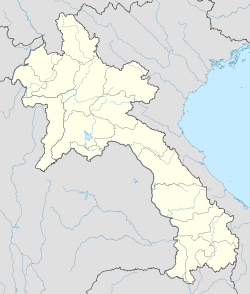Xam Neua
| Xamneua ຊຳເໜືອ Sam Neua, Samneua | |
|---|---|
| City | |
 | |
 Xamneua | |
| Coordinates: 20°24′48″N 104°02′53″E / 20.4133°N 104.0481°ECoordinates: 20°24′48″N 104°02′53″E / 20.4133°N 104.0481°E | |
| Country |
|
| Admin. division | Houaphan Province |
| Population (2002) | |
| • Total | 46,800 |
| • Religions | Buddhism |
Xam Neua (ຊຳເໜືອ [sám nɨ̌ə]; sometimes transcribed as Sam Neua or Samneua; literally "northern swamp") is the capital city of Houaphan Province, Laos, located in the northeast of the country. Xam Neua is one of the country's least visited provincial capitals by Western tourists.
Demographics
Residents are mostly Lao, Vietnamese and Hmong, along with some Tai Dam, Tai Daeng and Tai Lu. The predominant language is Lao with minorities of Vietnamese and Hmong. French is still spoken by a minority of people as a legacy of the French colonial era and is learnt by younger populations and used in public works and government.
Tourism
Several guesthouses are located in Xam Neua. There are irregular flights into/from Vientiane to Xam Neua (the airport's name is Nathon); presently operated by Lao Capricorn; see http://www.laocapricornair.net/schedule.php[].


Facts
Xam Neua is located in a valley in the Houaphan Province. In the early morning hours women wash clothes in the river flowing through the city. An elementary school is located near the main bridge crossing this river. At 5:45 am and pm each day there are public addresses from loudspeakers atop a tower on the school playground, expounding on the communist life and philosophy. These addresses are usually accompanied by Lao music. It is reputed there is a Communist re-education camp located in Xam Neua, and that it was the Pathet Lao capital during the Laotian Civil War Battle of Lima Site 85 (LS-85) 11 March 1968. It is near the Pathet Lao refuges in the Viengxay caves, which the Lao government hopes to promote as a tourism destination similar to the Củ Chi tunnels near Ho Chi Minh City in Vietnam, and the Killing Fields Memorial near Phnom Penh in Cambodia. It is also near the Nam Et-Phou Louey National Protected Area, (pronounced “naam et poo loo-ee”).[1]

| Wikimedia Commons has media related to Sam Neua. |